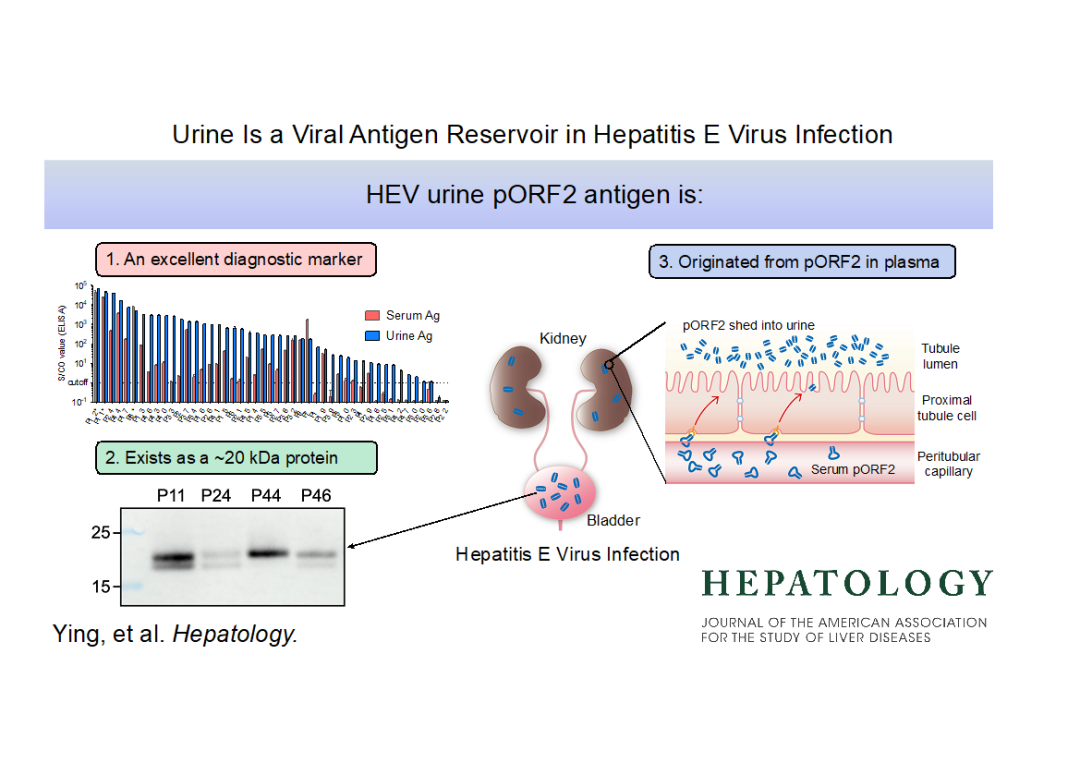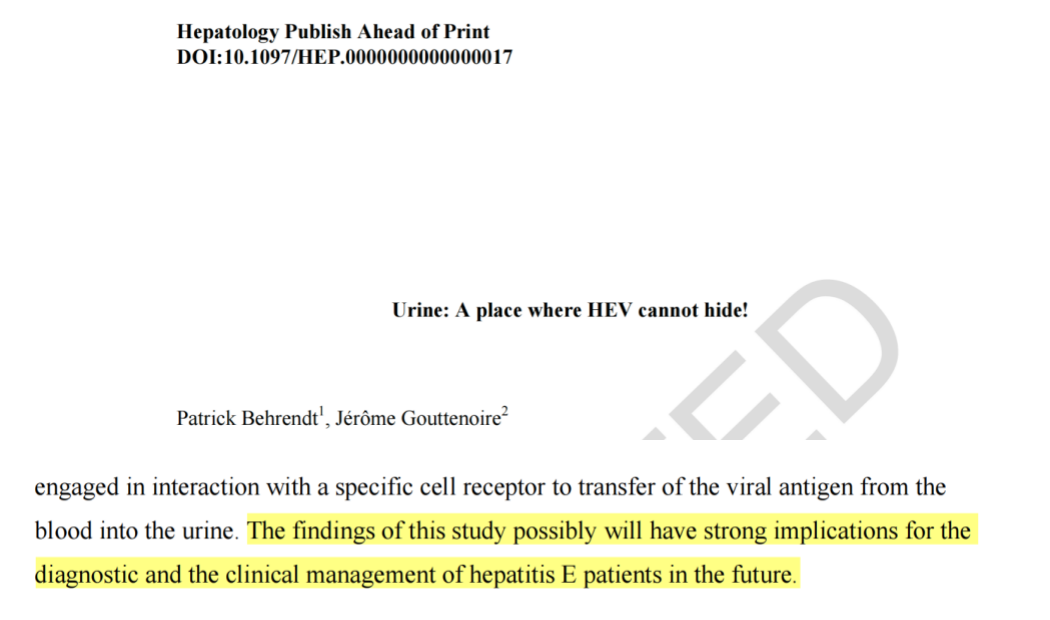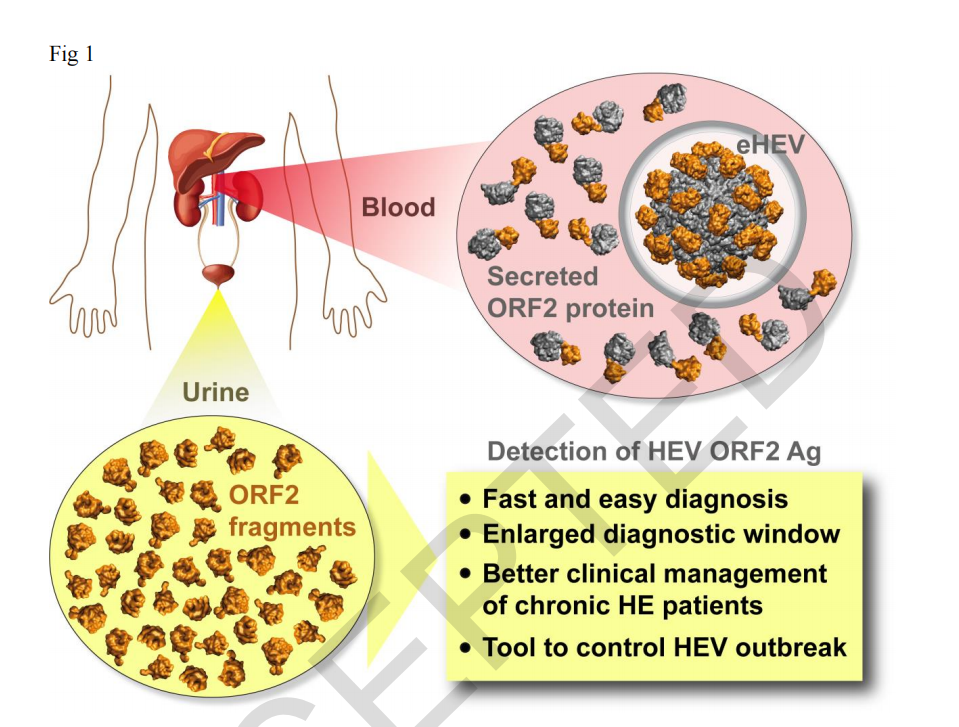尿液可以测肝炎?闻所未闻!
时间:2023-01-17 18:01:26 热度:37.1℃ 作者:网络
来源:小桔灯网
近期,厦门大学夏宁邵教授团队研究发现,患者尿液中可检出HEV Ag,其HEV ORF2 Ag水平是血液含量的10倍,这意味尿液抗原比血液中的检出时间更早,操作更方便!团队还首次揭示了尿液抗原的主要存在形式及代谢来源,相关成果《Urine Is a Viral Antigen Reservoir in Hepatitis E Virus Infection》被发表于Hepatology杂志(IF=14.971)!
近年来,戊型肝炎报告发病率呈上升趋势,报告发病数已连续10年远超甲肝,死亡率连续15年超过甲肝,其中对孕妇和老年人以及慢性肝病患者人群的危害最为严重。戊肝已成为不可忽视的肝脏疾病。围绕戊肝的预防与诊治,我国一直走在前列。厦门大学夏宁邵教授团队在全球范围内开展了许多前沿性研究并取得了一系列突破性成果。

针对夏宁邵教授团队的最新突破,《Hepatology》杂志副主编Patrick Behrendt特意撰文《Urine:A place where HEV cannot hide!》,给予该研究成果高度评价,指出:该发现或对全球戊型肝炎患者的临床诊断与治疗管理具有重大意义!

Patrick Behrendt指出,该研究成果首次在全球范围内将临床肝炎的诊断与治疗指导由血液或者粪便靶标转移至尿液中,鉴于本研究中尿液ORF2蛋白检测的灵敏度约为95%,一种基于易于采集的样本中病毒抗原的快速检测方法将极大地提升该病毒的诊断效率,实现及时检测!特别是在最小的实验室环境中。这就意味着在资源有限的地区开展HEV Ag 的检测不仅容易且可及时实施,尤其是在HEV集中爆发流行时,我们可以及时地了解病毒传播情况,及时采取必要的安全防护措施。特别是针对有严重感染风险的患者(如孕妇)提供更早的临床护理,降低重症风险!或将大大提升戊肝疫情防控效率!
此外,临床上,有潜在肝硬化或晚期纤维化的患者可在感染的晚期转介到移植中心接受肝移植评估。在这类病例中,往往通过血清学标志物进行HEV诊断。然而,有时不能立即排除不健康饮酒等导致的急性或者慢性肝损伤的可能因素,因此需要直接测量患者体内的病毒载量,由于HEV病毒血症期相当短,通过HEV RNA检测,特别是血浆中的检测结果可能已经呈阴性,而尿液中病毒衣壳的长时间释放可支持HEV的有效诊断,从而有助于实施适当的治疗措施,避免不必要因素导致病程延迟。
另外一个临床重要价值是或可有效地指导慢性戊肝的抗病度治疗,提示临床治疗终点。目前,临床上接受利巴韦林抗病毒治疗的慢性戊型肝炎患者,常以治疗结束时粪便中HEV-RNA阴性作为预测持续病毒学应答的可靠标志物。然而,由于目前的分析方法导致治疗结束时HEV RNA检出率增加,可能出现延长治疗无益,却出现因利巴韦林产生的严重不良反应。而尿液HEV Ag检测或可有效解决此问题,成为未来指导治疗的可能的优良指标。

目前,该研究的部分成果已由万泰生物成功转化生产,有望实现在15分钟内完成检测,该检测方法或将逐步进入全球大众视野,推动全球HEV诊断方法的革新,极大地提升临床HEV感染诊断效率,为全球肝炎防治再次贡献中国力量!
参考文献
1. 中 华 医 学 会 肝 病 学 分 会 . 戊 型 肝 炎 防 治 共 识 [J]. 中 华 肝 脏 病 杂 志 , 2022, 30(8):820-831. DOI: 10.3760/cma.j.cn501113-20220729-00401.
2. Ying D, He Q, Tian W, Chen Y, Zhang X, Wang S, Liu C, Chen Z, Liu Y, Fu L, Yan L, Wang L, Tang Z, Wang L, Zheng Z, Xia N. Urine is a viral antigen reservoir in hepatitis E virus infection. Hepatology. 2022 Sep 15. doi: 10.1002/hep.32745. Epub ahead of print. PMID: 36106666.
3. Kamar N, Izopet J, Pavio N, Aggarwal R, Labrique A, Wedemeyer H, Dalton HR. Hepatitis E virus infection. Nat Rev Dis Primers 2017;3:17086.
4. Kamar N, Abravanel F, Selves J, Garrouste C, Esposito L, Lavayssiere L, Cointault O, et al. Influence of immunosuppressive therapy on the natural history of genotype 3 hepatitis-E virus infection after organ transplantation. Transplantation 2010;89:353-360.
5. European Association for the Study of the Liver. EASL Clinical Practice Guidelines on hepatitis E virus infection. J Hepatol 2018;68:1256-1271.
6. Marion O, Lhomme S, Del Bello A, Abravanel F, Esposito L, Hebral AL, Lavayssiere L, et al. Monitoring hepatitis E virus fecal shedding to optimize ribavirin treatment duration in chronically infected transplant patients. J Hepatol 2019;70:206-209.
7. Montpellier C, Wychowski C, Sayed IM, Meunier JC, Saliou JM, Ankavay M, Bull A, et al. Hepatitis E virus lifecycle and identification of 3 forms of the ORF2 capsid protein. Gastroenterology 2018;154:211-223 e218.
8. Yin X, Ying D, Lhomme S, Tang Z, Walker CM, Xia N, Zheng Z, et al. Origin, antigenicity, and function of a secreted form of ORF2 in hepatitis E virus infection. Proc Natl Acad Sci U S A 2018;115:4773-4778.
9. Ying D, He Q, Tian W, Chen Y, Zhang X, Wang S, Liu C, et al. Urine is a viral antigen reservoir in hepatitis E virus infection. Hepatology 2022.
10. Marion O, Capelli N, Lhomme S, Dubois M, Pucelle M, Abravanel F, Kamar N, et al. Hepatitis E virus genotype 3 and capsid protein in the blood and urine of immunocompromised patients. J Infect 2019;78:232-240.
11. Geng Y, Zhao C, Huang W, Harrison TJ, Zhang H, Geng K, Wang Y. Detection and assessment of infectivity of hepatitis E virus in urine. J Hepatol 2016;64:37-43.
12. Behrendt P, Bremer B, Todt D, Steinmann E, Manns MP, Cornberg M, Wedemeyer H, et al. Significant compartment-specific impact of different RNA extraction methods and PCR assays on the sensitivity of hepatitis E virus detection. Liver Int 2021;41:1815-1823.
13. Patrick Behrendt1, Jérôme Gouttenoire. Urine: A place where HEV cannot hide!
—  —
—
: , 。 视频 小程序 赞 ,轻点两下取消赞 在看 ,轻点两下取消在看


